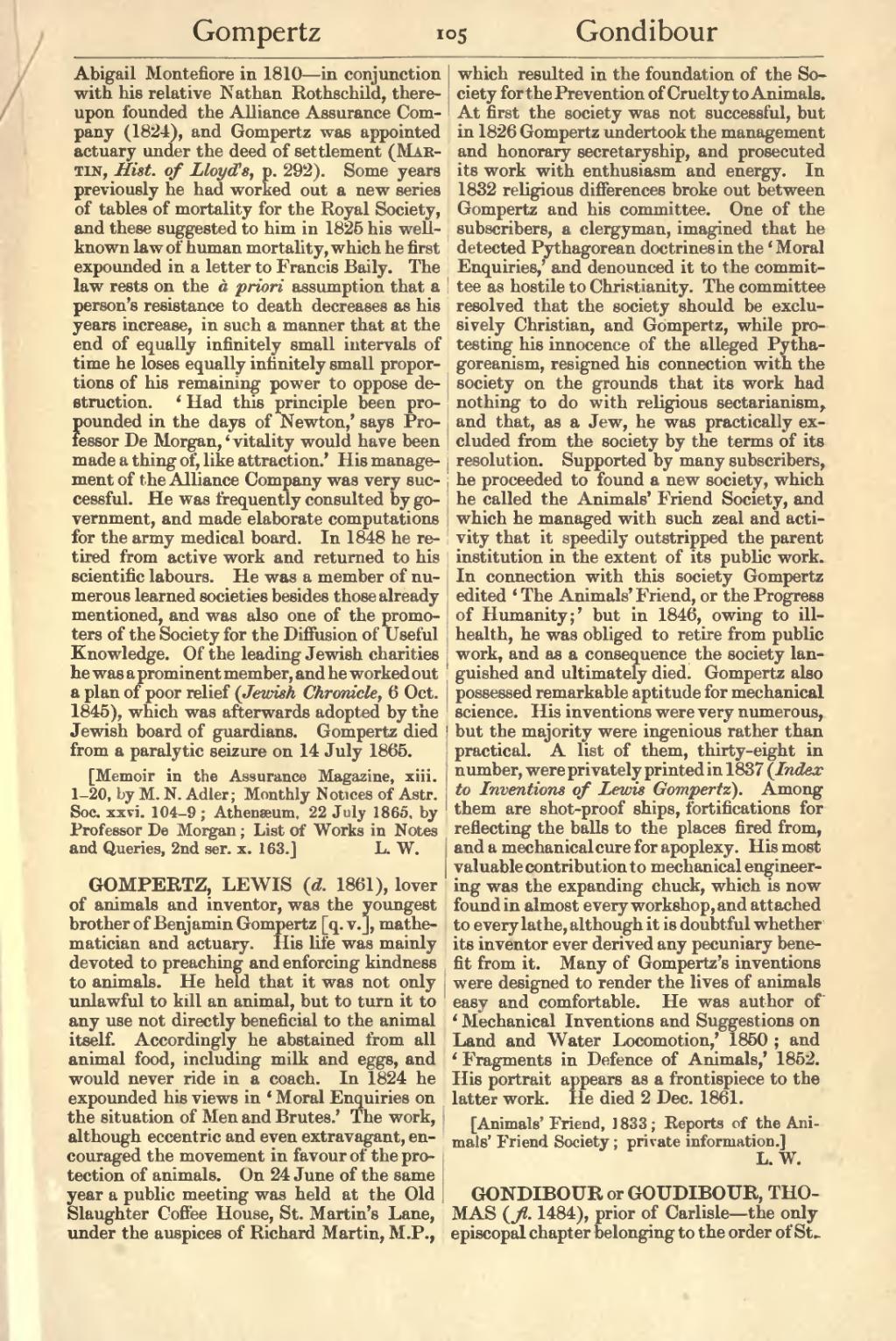Abigail Montefiore in 1810—in conjunction with his relative Nathan Rothschild, thereupon founded the Alliance Assurance Company (1824), and Gompertz was appointed actuary under the deed of settlement (Martin, Hist. of Lloyd's, p. 292). Some years previously he had worked out a new series of tables of mortality for the Royal Society, and these suggested to him in 1825 his well-known law of human mortality, which he first expounded in a letter to Francis Baily. The law rests on the à priori assumption that a person's resistance to death decreases as his years increase, in such a manner that at the end of equally infinitely small intervals of time he loses equally infinitely small proportions of his remaining power to oppose destruction. ‘Had this principle been propounded in the days of Newton,’ says Professor De Morgan, ‘vitality would have been made a thing of, like attraction.’ His management of the Alliance Company was very successful. He was frequently consulted by government, and made elaborate computations for the army medical board. In 1848 he retired from active work and returned to his scientific labours. He was a member of numerous learned societies besides those already mentioned, and was also one of the promoters of the Society for the Diffusion of Useful Knowledge. Of the leading Jewish charities he was a prominent member, and he worked out a plan of poor relief (Jewish Chronicle, 6 Oct. 1845), which was afterwards adopted by the Jewish board of guardians. Gompertz died from a paralytic seizure on 14 July 1865.
[Memoir in the Assurance Magazine, xiii. 1–20, by M. N. Adler; Monthly Notices of Astr. Soc. xxvi. 104–9; Athenæum, 22 July 1865, by Professor De Morgan; List of Works in Notes and Queries, 2nd ser. x. 163.]
GOMPERTZ, LEWIS (d. 1861), lover of animals and inventor, was the youngest brother of Benjamin Gompertz [q. v.], mathematician and actuary. His life was mainly devoted to preaching and enforcing kindness to animals. He held that it was not only unlawful to kill an animal, but to turn it to any use not directly beneficial to the animal itself. Accordingly he abstained from all animal food, including milk and eggs, and would never ride in a coach. In 1824 he expounded his views in ‘Moral Enquiries on the situation of Men and Brutes.’ The work, although eccentric and even extravagant, encouraged the movement in favour of the protection of animals. On 24 June of the same year a public meeting was held at the Old Slaughter Coffee House, St. Martin's Lane, under the auspices of Richard Martin, M.P., which resulted in the foundation of the Society for the Prevention of Cruelty to Animals. At first the society was not successful, but in 1826 Gompertz undertook the management and honorary secretaryship, and prosecuted its work with enthusiasm and energy. In 1832 religious differences broke out between Gompertz and his committee. One of the subscribers, a clergyman, imagined that he detected Pythagorean doctrines in the ‘Moral Enquiries,’ and denounced it to the committee as hostile to Christianity. The committee resolved that the society should be exclusively Christian, and Gompertz, while protesting his innocence of the alleged Pythagoreanism, resigned his connection with the society on the grounds that its work had nothing to do with religious sectarianism, and that, as a Jew, he was practically excluded from the society by the terms of its resolution. Supported by many subscribers, he proceeded to found a new society, which he called the Animals' Friend Society, and which he managed with such zeal and activity that it speedily outstripped the parent institution in the extent of its public work. In connection with this society Gompertz edited ‘The Animals' Friend, or the Progress of Humanity;’ but in 1846, owning to ill-health, he was obliged to retire from public work, and as a consequence the society languished and ultimately died. Gompertz also possessed remarkable aptitude for mechanical science. His inventions were very numerous, but the majority were ingenious rather than practical. A list of them, thirty-eight in number, were privately printed in 1837 (Index to Inventions of Lewis Gompertz). Among them are shot-proof ships, fortifications for reflecting the balls to the places fired from, and a mechanical cure for apoplexy. His most valuable contribution to mechanical engineering was the expanding chuck, which is now found in almost every workshop, and attached to every lathe, although it is doubtful whether its inventor ever derived any pecuniary benefit from it. Many of Gompertz's inventions were designed to render the lives of animals easy and comfortable. He was author of ‘Mechanical Inventions and Suggestions on Land and Water Locomotion,’ 1850; and ‘Fragments in Defence of Animals,’ 1852. His portrait appears as a frontispiece to the latter work. He died 2 Dec. 1861.
[Animals' Friend, 1833; Reports of the Animals' Friend Society; private information.]
GONDIBOUR or GOUDIBOUR, THOMAS (fl. 1484), prior of Carlisle—the only episcopal chapter belonging to the order of St.
